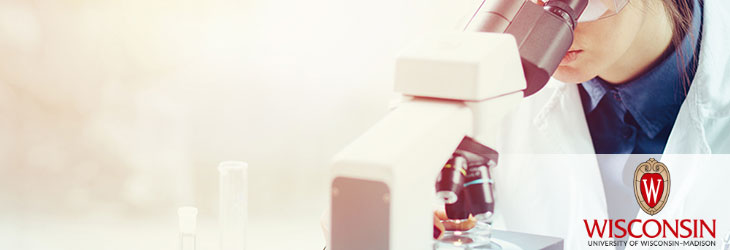Analytical Instrumentation, Methods & Materials

Multiplexed Mass Spectrometry Quantification with Neutron-Encoded Mass Tags
WARF: P130032US01
Inventors: Joshua Coon, Alexander Hebert
The Wisconsin Alumni Research Foundation (WARF) is seeking commercial partners interested in developing methods that combine the best aspects of SILAC and isobaric tagging for more accurate proteomic quantification in a large number of samples.
Overview
In the past decade, cataloguing the thousands of proteins present in a cell using mass spectrometry (MS) has matured into a procedure both deeply vital and straightforward. Yet discovering how such molecules change in abundance under various circumstances remains a challenge.
A key step in most quantification strategies is to flag molecules of interest with stable isotopes that then can be detected and tallied by MS analysis. Two main approaches seek to accomplish this. SILAC (stable isotope labeling with amino acids in cell culture) incorporates ‘light’ or ‘heavy’ amino acids into proteins during cell growth. However, multiplexing (testing four or more samples simultaneously) is arduous with SILAC and redundant mass/charge peaks can lead to spectral complexity. Also, the technique is incompatible with mammalian biofluids and tissues. Isobaric tagging is a chemical labeling approach developed to overcome these issues, but interference from other molecules tends to degrade accuracy.
To empower modern proteomics and medicine, a new approach must support expanded, multiplexed analyses with heightened accuracy and reproducibility.
A key step in most quantification strategies is to flag molecules of interest with stable isotopes that then can be detected and tallied by MS analysis. Two main approaches seek to accomplish this. SILAC (stable isotope labeling with amino acids in cell culture) incorporates ‘light’ or ‘heavy’ amino acids into proteins during cell growth. However, multiplexing (testing four or more samples simultaneously) is arduous with SILAC and redundant mass/charge peaks can lead to spectral complexity. Also, the technique is incompatible with mammalian biofluids and tissues. Isobaric tagging is a chemical labeling approach developed to overcome these issues, but interference from other molecules tends to degrade accuracy.
To empower modern proteomics and medicine, a new approach must support expanded, multiplexed analyses with heightened accuracy and reproducibility.
The Invention
UW–Madison researchers have developed customized tagging reagents for MS proteome quantification. Called neutron encoded mass tagging, or ‘NeuCode,’ the method exploits small mass differences, on the order of millidaltons (mDa), between heavy isotopes, such as nitrogen or carbon, which can be coupled with amino acids used during cell culture similarly to SILAC. Through instrument resolution settings, NeuCode labeling allows the user to control when multiplexed information is masked, limit sample complexity, and when it is revealed, produce quantitative data. Furthermore, these mDa mass differences can be incorporated into novel chemical tags that couple to peptides and enable analysis of biological samples from any source. Unlike isobaric tags, however, specialized reporter groups, linkers and charge sites are not required.
Applications
- Relative or absolute quantification of analytes, including amino acids, metabolites, peptides and proteins
Key Benefits
- Empowers high throughput and accuracy
- Useful for large number of samples at once
- Compatible with biological tissues and fluids
- Alleviates spectral complexity problem
- No precursor interference caused by co-isolating impurities
- Does not require MS/MS scan
- Dissociation can be accomplished by any fragmentation method.
Stage of Development
An initial version of the tag has been tested and shown to enable 12- and 18-plex analysis at current MS resolving powers with the potential of 27-plex testing if resolution is doubled.
Additional Information
For More Information About the Inventors
Related Technologies
Tech Fields
For current licensing status, please contact Jennifer Gottwald at [javascript protected email address] or 608-960-9854